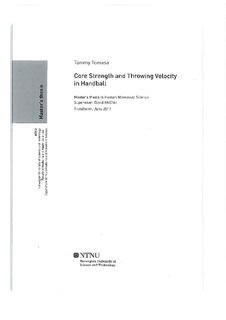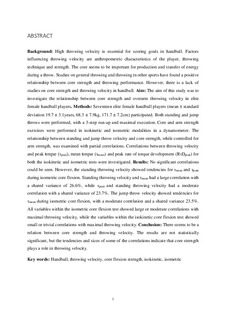| dc.description.abstract | Background: High throwing velocity is essential for scoring goals in handball. Factors influencing throwing velocity are anthropometric characteristics of the player, throwing technique and strength. The core seems to be important for production and transfer of energy during a throw. Studies on general throwing and throwing in other sports have found a positive relationship between core strength and throwing performance. However, there is a lack of studies on core strength and throwing velocity in handball.
Aim: The aim of this study was to investigate the relationship between core strength and overarm throwing velocity in elite female handball players. Methods: Seventeen elite female handball players (mean ± standard deviation 19.7 ± 3.1years, 68.3 ± 7.9kg, 171.7 ± 7.2cm) participated. Both standing and jump throws were performed, with a 3-step run-up and maximal execution. Core and arm strength exercises were performed in isokinetic and isometric modalities in a dynamometer. The relationship between standing and jump throw velocity and core strength, while controlled for arm strength, was examined with partial correlations. Correlations between throwing velocity and peak torque (τpeak), mean torque (τmean) and peak rate of torque development (RτDpeak) for both the isokinetic and isometric tests were investigated.
Results: No significant correlations could be seen. However, the standing throwing velocity showed tendencies for τmean and τpeak during isometric core flexion. Standing throwing velocity and τmean had a large correlation with a shared variance of 26.6%, while τpeak and standing throwing velocity had a moderate correlation with a shared variance of 23.7%. The jump throw velocity showed tendencies for τmean during isometric core flexion, with a moderate correlation and a shared variance 23.5%. All variables within the isometric core flexion test showed large or moderate correlations with maximal throwing velocity, while the variables within the isokinetic core flexion test showed small or trivial correlations with maximal throwing velocity.
Conclusion: There seems to be a relation between core strength and throwing velocity. The results are not statistically significant, but the tendencies and sizes of some of the correlations indicate that core strength plays a role in throwing velocity. | nb_NO |

